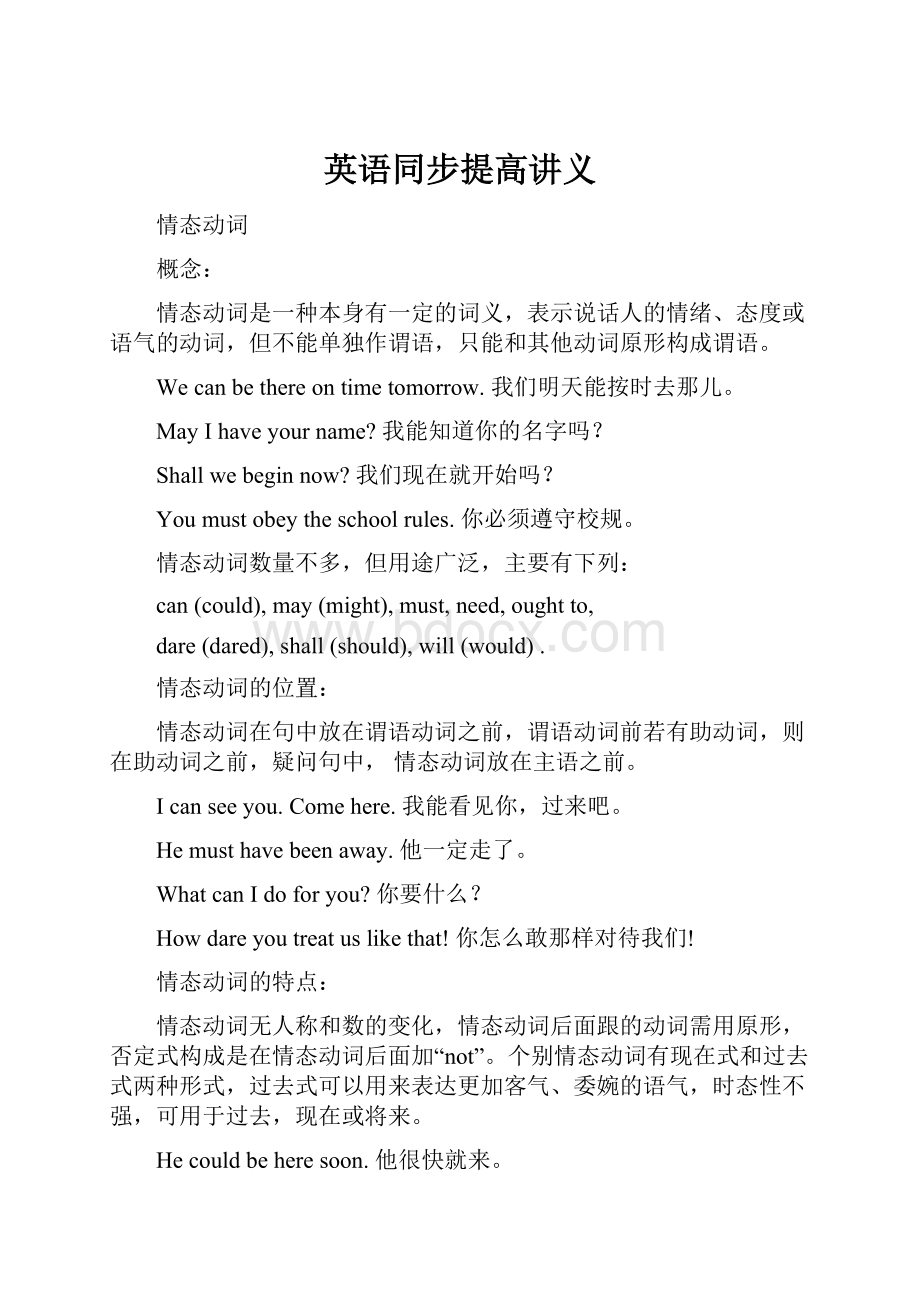英语同步提高讲义.docx
《英语同步提高讲义.docx》由会员分享,可在线阅读,更多相关《英语同步提高讲义.docx(45页珍藏版)》请在冰豆网上搜索。

英语同步提高讲义
情态动词
概念:
情态动词是一种本身有一定的词义,表示说话人的情绪、态度或语气的动词,但不能单独作谓语,只能和其他动词原形构成谓语。
Wecanbethereontimetomorrow.我们明天能按时去那儿。
MayIhaveyourname?
我能知道你的名字吗?
Shallwebeginnow?
我们现在就开始吗?
Youmustobeytheschoolrules.你必须遵守校规。
情态动词数量不多,但用途广泛,主要有下列:
can(could),may(might),must,need,oughtto,
dare(dared),shall(should),will(would).
情态动词的位置:
情态动词在句中放在谓语动词之前,谓语动词前若有助动词,则在助动词之前,疑问句中,情态动词放在主语之前。
Icanseeyou.Comehere.我能看见你,过来吧。
Hemusthavebeenaway.他一定走了。
WhatcanIdoforyou?
你要什么?
Howdareyoutreatuslikethat!
你怎么敢那样对待我们!
情态动词的特点:
情态动词无人称和数的变化,情态动词后面跟的动词需用原形,否定式构成是在情态动词后面加“not”。
个别情态动词有现在式和过去式两种形式,过去式可以用来表达更加客气、委婉的语气,时态性不强,可用于过去,现在或将来。
Hecouldbeheresoon.他很快就来。
Wecan'tcarrytheheavybox.我们搬不动那箱子。
I'msorryIcan'thelpyou.对不起,我帮不上你。
can
can表示能力、技能、许可、建议、请求和可能性.
could
比较委婉客气地提出问题或陈述看法,一般用could,回答时则用can。
---Couldyouhelpmecarrythebag?
---Yes,Ican.
may/might
may/might表示可能,但may比might可能性大。
--Whyisn’theinclass?
--Hemaybesick.(生病的可能性较大)
Hemightbesick.(生病的可能性较小)
may/might表示“允许”,may用于现在时或将来时,might常用在间接引语中表过去时.
Hesayswemayleave.
Hesaidwemightleave.
"mayyou+动词原形"放在句首,意为"祝愿;但愿"。
Mayyousucceed!
祝你成功!
Mayyoubehappyeverysingleday.祝你天天快乐。
must/mustn’t
①must表示必须,应该,没有时态变化。
YoumustdoeverythingasIdo.
②must表示肯定的推测。
Thelightisstillon,sohemustbeathome.
③mustn’t表示禁止做某事。
Youmustn’tsmokeintheoffice.
should/shouldn’t
①should表示应当、应该;
Youshouldworkhard.
②should可表示陈述意见,提出建议或请求;
Hesuggestedthattheyshouldleaveatonce.
③should的否定形式表示禁止之意。
Childrenshouldn’tsmoke.
shouldhavedone/shouldn’thavedone
shouldhavedone表示“本来应该做某事而实际上未做”,而shouldn’thavedone则表示“本不应该做某事而实际上做了”。
Youshouldhavetoldmeaboutitearlier.
Youshouldn’thavesaidsuchwordstoyourparents.
hadbetter/hadbetternot
You’dbetterdosth你最好做某事
You’dbetterbuythebook.
You’dbetternotdosth你最好不要做某事
You’dbetternotrunintheclassroom.
题一
题面
oughtto
oughtto+动词原形。
“应当;应该”
如果你想知道如何修理汽车,你应该读这些书。
You______________________ifyouwanttoknow____________________.
你应该把孩子带来。
You_________________thechildhere.
need
need既可用作情态动词,又可用作实义动词。
作情态动词时,没有数和人称的变化,后接动词原形;
作实义动词时,有数的变化和人称的变化,后接带to的不定式。
注意:
作为情态动词,need一般不能用于肯定句中,仅用于否定句、疑问句和条件状语从句中。
作为情态动词,need后也不能直接加sth.
如果是needsth,那么这个need一定是实义动词need.
用于否定句,表“不必”。
Youneedn’tworry. 你不必担心。
Idon’tthinkyouneedworry. 我想你不必担心。
用于疑问句,表“需要吗”?
Needyougo?
你得去吗?
-----No,Ineedn’t.不必。
-----Yes,Imust.是的,我必须去。
作为情态动词的need的正确形式。
needsbdosth.
sb.needn’tdosth.
need用作实义动词时,要注意始终以实义动词的标准。
(正确)Doyouneedtogothere?
(错误)Doyouneedgothere?
作为实义动词的need的正确形式。
needtodo
needstodo
don’t/doesn’t/didn’tneedtodo
Do/Does/Didsbneedtodosth?
题二
题面
dare
“敢”,多用在否定或疑问句中。
小女孩不敢在公众面前说话。
Thelittlegirl_____________________.
你敢抓小猫吗?
__________________thelittlecat?
dare除用作情态动词外,更多的是当实义动词使用,用法同实义动词一样,要考虑人称,单复数,时态等。
_______________________inthedark?
你敢黑夜走路吗?
He_____________________theteacherwhathappenedthatday.
他不敢告诉老师那天发生的事。
can/beableto
表示"能够"意义的can与beableto的区别。
在表示能力时,can与beableto的意义差不多,有时两者可换用,但表示"经过努力、设法做成某事"时,要用beableto,不可用can。
You'llbeabletoreaditbeforelong.
Withthehelpofthestick,hewasabletoswimtothebank.
can’t与mustn’t
表示"不能"意义的can’t与mustn’t的区别。
can’t表示“不能”,意指没有能力;
mustn’t表示"不能",意指"禁止;不允许"。
Thebabyisasleep.Youmustn’tmakeanynoise.
Theboyissotiredthathecan’twalkanyfurther.
must/haveto
表示"必须"的must与haveto的区别。
must表示说话人的主观看法;而haveto则表示由于某种外界(客观)原因而“必须”,“不得不”做某事。
mustn't意为"不可以;不允许";don'thaveto意为"不必"。
Myfatherhadtoworkwhenhewastenyearsold.
Theplayisnotinteresting.Ireallymustgonow.
定义:
在复合句中由从句表示的状语称作状语从句,它可以用来修饰谓语(包括非谓语动词)、定语或状语,或是整个句子。
准确掌握每一个连词的含义是掌握状语从句的关键。
同时要注意主从句的时态呼应。
状语从句一般分为九大类
状语从句类别:
时间状语从句地点状语从句原因状语从句目的状语从句结果状语从句
条件状语从句方式状语从句比较状语从句让步状语从句时间状语从句
引导时间状语从句的连词有:
when,while,as,themoment,before,after,till,until,since,assoonas等。
when,while,as的区别
when---当……时候,通常指某一特定的时间点,主句与从句的动作同时发生。
WhenIopenedthewindow,Isawhimcomeup.
WhenIhavetime,Iwillgotoseeyou.
WhenIcamehome,Imetanoldschoolmateofmine.
Hesaidhewouldtellheraboutitwhenhesawher.
注意:
在时间状语从句中,主从句都是将来的动作或状态时,习惯上主句用将来时,从句用一般现在时。
when---正在……的时候,突然…。
通常主句是进行时或beaboutto时,在翻译的时候,when可以译成没想到或突然。
Iwaswalkingalongthestreet,whenImethim.
Iwasabouttofallasleepwhenmysistercamein.
Oneevening,littleHanswassittingnearthefirewhenheheardaloudknockatthedoor.
when当从句是进行时,主句是一般时,往往表示不满。
SomeoneknockedatthedoorwhenIwashavingbreakfast.
WhenIwasleavingthehouse,thepostmanarrived.
when=after
Whenthechildrenhadgonetobed,shebeganto
prepareherlessons.
while---在……期间,往往指一段时间。
WhilewewereinAmerica,wesawhimtwice.
Whileweweretalking,hecamein.
Strikewhiletheironishot.
while---表示一种不满情绪,意思是这边在干某种重要的事,而另一边在享受等。
Wearecleaningtheclassroomwhiletheyareplayingfootball.
Thesoldierfacesthepowderwhilethebeautypowdertheface.
as---一边……一边,随着
Shewasdoingherhomeworkasshewaslisteningtothemusic.
Asshegrewolder,shebecamemorebeautiful.
as---当……时,指一个动作紧接着一个动作发生,从句通常用进行时。
AsIwasgoingout,itbegantorain.
IsawMaryasshewasgoingonthebus.
Ashewaseatinghisbreakfast,heheardsomeoneknockatthedoor.
SomeonepattedmeontheshoulderasIwasstandingbeforetheshopwindow.
themoment---一……就……=assoonas,immediately
---DidyouremembertogiveMarythemoneyyouowedher?
---Yes,IgaveherthemomentIsawher.
not…until---直到……才
Hedidn’tleavetheofficeuntilhefinishedthework.
=Helefttheofficewhenhefinishedthework.
Not…until可以和when互换
before---在……之前
Thepassengersshouldarriveattheairportanhourbeforetheflightdeparts.
HeranoffbeforeIcouldstophim.
ItwasnotlongbeforeIforgotitall.
(Itwas/willbe…before…是常用句型)
after---在……之后
Thecustomerlefttheticketcounterafterhehadaquarrelwiththeticketagent.
Theplanetookoffaftertheairtrafficcontrollergaveclearance.
since---自从……,通常主句用现在完成时
IhaveneverbeenthereagainsinceIgraduatedfromtheuniversity.
Thecaptainhastravelledalmosteverywhereintheworldsincehebecameapilot.
Itisjustaweeksincewearrivedhere.
(Itis/hasbeen…since…是常用句型)
assoonas---一……就……
Jackwenttoschoolassoonashegotwell.
I’llringyouupassoonasIgetananswerfromhim.
nosoonerthan---一……就……
Nosoonerhadhearrivedthanhewentawayagain.
nosooner…than…用于句首要求倒装
Hardly…when…
Scarcely…when…
once---一旦……就……
Onceyouseehim,youwillneverforgethim.
everytime,eachtime每次whenever每当
Eachtimehecametotown,hewouldvisitourschool.
Wheneverwemetwithdifficulties,theycametohelpus.
Guessthemeaningofthefollowingproverbs
Godhelpsthosewhohelpthemselves.
自助者天助之。
Hewholaughslastlaughsbest.
谁笑到最后,谁笑得最好。
HewhodoesnotreachtheGreatWallisnotatrueman.
不到长城非好汉。
定语:
是对名词或代词起修饰、限定作用的词、短语或句子,汉语中常用“……的”表示。
acleverboytheboilingwater
fallenleavesThemanwhoyouarelookingfor
定语从句
定语从句:
修饰某一名词或代词的从句。
DoyouknowthemanwhocametoseeXiaoYangthismorning?
Tomisahandsomeboy.
Thelittleboyneedsabluepen.
Theboyintheclassroomneedsapen.
ThepenboughtbyherismadeinChina.
Themanstandingthereismyteacher.
Theboywhoisreadingneedsthepenwhichyouboughtyesterday.
小结论:
单词或单个的分词作定语时通常放在它所修饰的词之前,作前置定语。
分词短语,介短和从句作定语时则放在所修饰的词之后,作后置定语。
先行词:
被修饰的名词或代词。
关系词引导定语从句的关联词称为关系词,关系词有关系代词和关系副词。
关系代词:
that,which,who,whom,whose,as
关系副词:
where,when,why
重要推论:
关系词的3个作用
1·引导定语从句。
2·代替先行词。
3·在定语从句中担当一个成分。
警示:
关系代词在从句中作主语时,从句的谓语动词的人称和数必须与先行词保持一致。
Thosewhoareagainsttheplanputupyourhands.
Themanwhoisnexttoussellsvegetable.
※典型考点
变为定语从句
Helovesbasketball.
Heplaysbasketballverywell.
变为定语从句
Heisafamousbasketballplayer.
HiswifeisYeLi.
关系代词that,which引导的定语从句:
如果先行词是表示物的名词或代词,关系代词应用that、which.(作主语或宾语)
which/that作主语.(不能省)
Thisisadream.Thedreamwillnevercometrue.
Thisisadreamwhich/thatwillnevercometrue.Thedoghasbeenfound.
Thedogwaslost.Thedogwhichwaslosthasbeenfound.
(作主语)
which/that作宾语:
(可省略)Thisisthecard.
I’vejustreceivedthecard.
Thisisthecard(which/that)I’vejustreceived.作宾语
关系代词who,that,whom引导的定语从句:
如果先行词是表示人的名词或代词,关系代词应用
who,that(作主语或宾语)whom(作宾语)
who/that作主语.(不能省)Thisisthefilmstar.
ThefilmstarisverypopularinChina.
Thisisthefilmstarwho/thatisverypopularinChina.(作主语)
who/whom/that作宾语:
(可省略)
Themanisafamouswriter.Hedescribedthemanjustnow.
Theman(who/whom/that)hedescribedjustnowisafamouswriter.(作宾语)
小结:
that-既可指人,也可指物,作主语,不能省略;作宾语,可以省略。
which-指物,作主语,不能省略;作宾语,可以省略.
who-指人,作主语,不能省略;作宾语,可以省略,(常用whom)
注:
当关系代词在定语从句中作主语时,定语从句的谓语动词形式由先行词决定。
whose作定语,表示所属关系。
Theboyismyclassmate.Theboy’sfatherisapoliceman.
Theboywhosefatherisapolicemanismyclassmate.
Theboywhoisreadingneedsthepen.
whose引导的定语从句注意点
whose引导定语从句,其后应紧跟名词,构成名词短语。
whose与它所修饰的名词一起可以作介词的宾语。
Thebossinwhosedepartmentheworkedhadheardthenews.
whose引导的定语从句,其先行词既可以指人也可以指物。
whose的先行词指物时,可用ofwhich代替,但语序不同,即whose+名词=the+名词+ofwhich,或=ofwhich+the+名词。
Thenovelwhosetitle(=thetitleofwhich或ofwhichthetitle)isRedandBlackisveryinteresting.
whose的先行词指人时,可用ofwhom代替,但语序不同,即whose+名词=the+名词+ofwhom,或=ofwhom+the+名词。
Theboywhosemother(=themotherofwhom或ofwhomthemother)isadoctorismyfriend.
祈使句
祈使句可以表达说话人的意愿、请求、叮嘱、号召、命令或建议,它的主语you(听话人)通常省略,谓语动词用原形,句子末尾用感叹号或句号,读时用降调。
祈使句的肯定形式
be型(系动词原形be+表语+其它)Becareful!
Don’tgotoohigh.
Bequiet,everyone!
do型(行为动词+宾语+其它)
Comein,please!
Ple